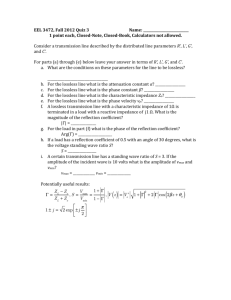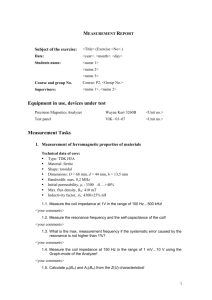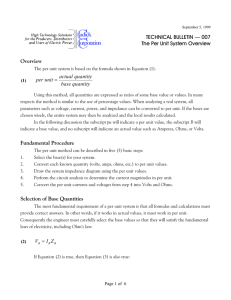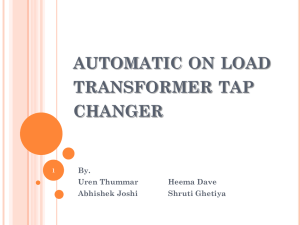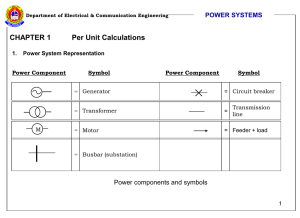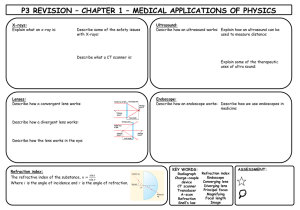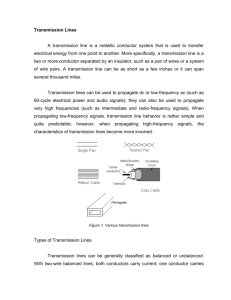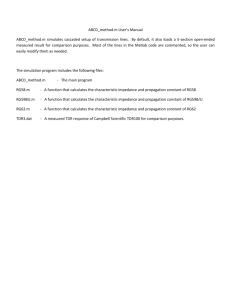Chapter 3: From lumped to distributed elements
advertisement
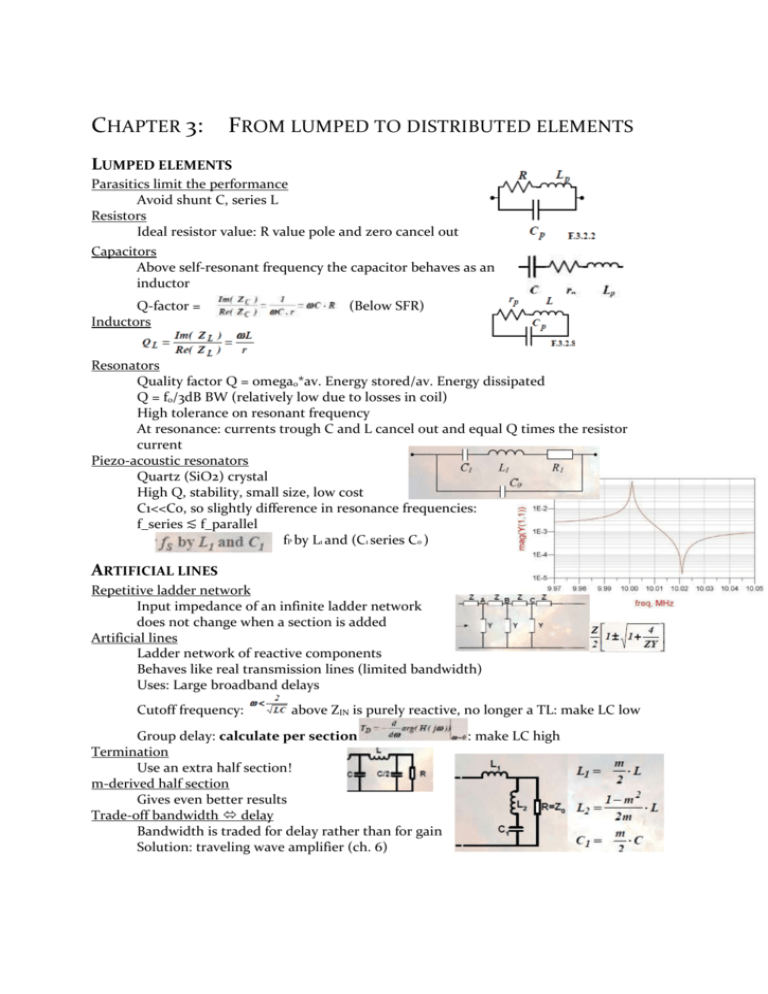
CHAPTER 3: FROM LUMPED TO DISTRIBUTED ELEMENTS LUMPED ELEMENTS Parasitics limit the performance Avoid shunt C, series L Resistors Ideal resistor value: R value pole and zero cancel out Capacitors Above self-resonant frequency the capacitor behaves as an inductor Q-factor = Inductors (Below SFR) Resonators Quality factor Q = omega0*av. Energy stored/av. Energy dissipated Q = f0/3dB BW (relatively low due to losses in coil) High tolerance on resonant frequency At resonance: currents trough C and L cancel out and equal Q times the resistor current Piezo-acoustic resonators Quartz (SiO2) crystal High Q, stability, small size, low cost C1<<C0, so slightly difference in resonance frequencies: f_series ≲ f_parallel fP by L1 and (C1 series C0 ) ARTIFICIAL LINES Repetitive ladder network Input impedance of an infinite ladder network does not change when a section is added Artificial lines Ladder network of reactive components Behaves like real transmission lines (limited bandwidth) Uses: Large broadband delays Cutoff frequency: above ZIN is purely reactive, no longer a TL: make LC low Group delay: calculate per section Termination Use an extra half section! m-derived half section Gives even better results Trade-off bandwidth delay Bandwidth is traded for delay rather than for gain Solution: traveling wave amplifier (ch. 6) : make LC high TRANSMISSION LINES Telegrapher equations equals Two waves propagating in opposite direction: incident and reflected wave Terminated lossless transmission line Gamma = 0: line is perfectly terminated no reflections Return loss (RL) dB = -20 log|Gamma| Voltage standing wave ratio (VSWR) = 1+|Gamma|/1-|Gamma| Easy way to measure matching Gamma vs. ZIN Gamma tells everything about input impedance at distance l from the load Gamma(l): rotates clockwise around the origin as l increases: lambda/2 => full circle Two port models Lossy transmission lines In the conductor: skin effect arises: High Z0 In the dielectric (G): stray current between transmission lines: Low Z0 Causes: attenuation and dispersion Dispersion free when L/R = C/G Stubs Shorted: can replace an inductor Open: can replace a capacitor Higher Q, cheaper at high f only at GHz Quarter wavelength TL transformer => The load impedance is inverted with a scale factor Short=>Open; L=>C; up or down transforming of Z2 Very dispersive BROADBAND COMPONENTS Port properties Reciprocal lossless three-port cannot de matched at three ports Lossless reciprocal four-ports with two matched and reciprocally decouples ports are matched and decoupled at the two other ports Reciprocal lossless circuits with four matched ports always have two reciprocally decoupled ports; these circuits are called 4-ports couplers Power dividers and combiners Directional couplers <= 90° Separate left/right traveling waves Insertion loss = P1/P2 (dB) 180°=> Coupling = P1/P3 (dB) Isolation = P1/P4 (dB) Directivity = P3/P4 = I-C, ability to isolate forward and backward waves 90° all limited bandwidth 180° Transformer 180° hybrid is not resonant, so it’s broadband Transformers Autotransformer (tapped coil) vs. Conventional transformer Restrictions: LF: tau0 = Lm/R needs to be increased -> N big HF: tauc = RCp or Ls/R lowered -> N small Transmission line transformer Stray inductance (Ls) and winding capacitance (Cp) absorbed Line must be short compared to the wavelength => both ends in phase Impedance for maximum BW = ratio of in/output voltage to the current trough the line Unbalanced - unbalanced Impedance transformer Balanced – unbalanced Signal on both ports 1:4 balun with very high BW 1:4/9 balun for push-pull amplifiers Two parallel amplifiers in anti-phase Combining the output power of two Linear amplifiers (e.g. class B) Use a hybrid (transformer + resistor) combiner Advantages: Combining 2 amplifiers o Power doubles o OIP + 3dB Using anti-phase amplifiers o Even harmonics are suppressed Extra component Rh o One more degree of freedom • equal PALOAD = R Directional bridge Accepts loss to extend bandwidth (to DC) To separate transmitted/reflected waves SURFACE ACOUSTIC WAVE DEVICES In contrast with Bulk acoustic waves Central frequency between 10M-2GHz Interdigital transducer (IDT) Fundamental resonance frequency: Lambda = IDT period SAW transversal filter Use two IDTs one for generating and one for capturing FIR filter Greater loss Constant pass band group delay How to build IDT is trapped between two Bragg reflector gratings => high Q
